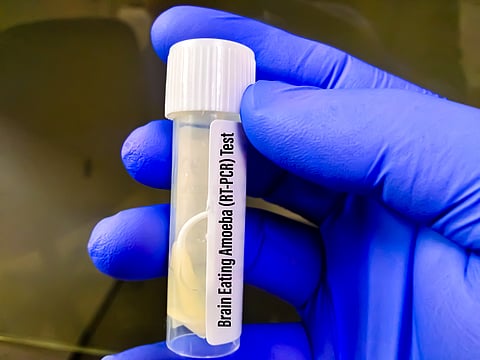

In the second week of August, a tragedy in a small Kozhikode village forced Kerala to confront a new health crisis. Anaya, a Class IV student returning home tired from school, fell ill overnight with fever and vomiting. Her family suspected a routine infection. But within a day, despite being admitted to hospital, she was gone.
Tests later revealed that the child had succumbed to amoebic meningoencephalitis, a rare brain infection caused by free-living amoebae found in ponds, wells, and rivers. Her sudden death was followed by a cluster of similar cases across Kozhikode, Malappuram and Wayanad, pulling the curtain back on a microscopic killer long dismissed as a medical curiosity elsewhere.
The culprit, Naegleria fowleri, is often referred to as the ‘brain-eating amoeba’. It thrives in warm freshwater and enters the body through the nose, travelling silently to the brain and destroying tissue with terrifying speed.
Globally, the disease it causes—primary amoebic meningoencephalitis (PAM)—was first identified in 1965 in Adelaide, Australia, after several children died following swims in contaminated pools.
In the decades since, PAM has been reported from the southern United States, where summer outbreaks in Florida, Texas and Arizona remain a recurring fear; from Karachi in Pakistan, where poorly chlorinated municipal water is a persistent problem; and from Latin America, China and Japan, where clusters have been linked to both stagnant water and unsafe cultural practices.
The second form of the infection, granulomatous amoebic encephalitis (GAE), has also emerged worldwide since the 1970s, particularly among immunocompromised patients in the Americas and Asia.
For decades, India reported only sporadic cases from Tamil Nadu, Maharashtra, Gujarat and West Bengal, almost always fatal. Kerala’s first recorded death came in Alappuzha in 2016. But the state, which prided itself on low infant mortality, high life expectancy and a primary healthcare network celebrated as a model for the developing world, is now grappling with an unprecedented surge.
In 2024, Kerala reported 29 confirmed cases, mostly concentrated in its southern districts. Unlike the rest of the world, where fatality exceeds 97 per cent, Kerala managed to save 24 patients by deploying aggressive treatment protocols and importing the anti-parasitic drug miltefosine.
Even so, the deaths of children like Anaya have shaken public confidence.
Doctors and epidemiologists link this surge to a disturbing convergence of factors: rising temperatures due to climate change, unchecked contamination of wells and ponds with sewage and organic waste, and the persistence of community practices that expose children to untreated water.
In Kozhikode’s Omassery, the well from which a three-month-old baby’s family drew drinking water tested positive for Naegleria. In Malappuram, villagers abandoned a crystal-clear pond after a 16-year-old boy who swam there died within days. In Thiruvananthapuram’s Athiyannoor, investigators discovered that not just bathing but a local practice of sniffing water mixed with tobacco powder had given the amoeba a direct route to the brain. These seemingly ordinary acts now carry extraordinary risks.
The state’s health system has scrambled to adapt. Until recently, Kerala had to send samples to Chandigarh for confirmatory diagnosis, losing crucial time. Now, its own public health laboratory in Thiruvananthapuram can identify multiple pathogenic amoeba species. Clinicians across the state have been trained to ask meningitis patients about recent freshwater exposure and to begin immediate treatment if suspicion arises.
This aggressive vigilance, coupled with experience honed during repeated Nipah outbreaks in Kozhikode, explains the unusual survival rate. Yet the strain on doctors, laboratories and intensive care units is evident, underscoring how even Kerala’s much-lauded healthcare network can be unsettled by a microscopic adversary.
Scientists warn that Kerala may only be witnessing the beginning. Naegleria fowleri is no longer confined to ponds and still waters; it has been isolated from wells, tanks, soil and even dust. Its spread is inseparable from a warming climate that is altering microbial ecologies, and from unsafe water practices that remain common across villages.
“Because of the rise in atmospheric temperature, microorganisms such as Naegleria fowleri that thrive in high-temperature environments have gained a dangerous prominence,” notes T S Anish of the Kerala One Health Centre.
His words echo a larger fear: Kerala’s famed health transition, once celebrated as a Third World success story, is increasingly vulnerable to pathogens whose behaviour is changing with the climate.
The story of Anaya and others who fell ill this monsoon is thus more than a medical case study. It is a warning. Kerala has demonstrated that lives can be saved from a disease once deemed uniformly fatal. But the state’s experience also shows how fragile even robust healthcare achievements can be in the face of ecological shifts, changing pathogens, and global warming.
The amoeba is not Kerala’s only worry. Recurring outbreaks of Nipah virus in Kozhikode, rising dengue and leptospirosis cases during the monsoon, surges in scrub typhus and rat fever, and even the looming threat of antimicrobial resistance are beginning to erode the state’s hard-won health gains. The arrival of the ‘brain-eating amoeba’ merely underlines the scale of the challenge: a small, invisible pathogen that not only kills children but also threatens to rewrite Kerala’s narrative as India’s model healthcare state.